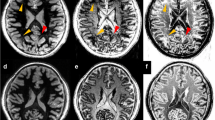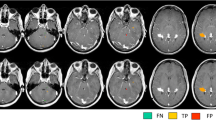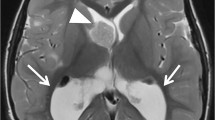Abstract
Background: Tuberous sclerosis (TS) is a neurocutaneous genetically inherited disease with variable penetrance characterized by dysplasias and hamartomas affecting multiple organs. MR is the imaging method of choice to demonstrate structural brain lesions in TS. Objective: To compare MR sequences and determine which is most useful for the demonstration of each type of brain lesion in TS patients. Materials and methods: We reviewed MR scans of 18 TS patients for the presence of cortical tubers, white matter lesions (radial bands), subependymal nodules, and subependymal giant cell astrocytoma (SGCA) on the following sequences: (1) T1-weighted spin-echo (T1 SE) images before and after gadolinium (Gd) injection; (2) nonenhanced T1 SE sequence with an additional magnetization transfer contrast medium pulse on resonance (T1 SE/MTC); and (3) fluid-attenuated inversion recovery (FLAIR) sequence. Results: Cortical tubers were found in significantly (P<0.05) larger numbers and more conspicuously in FLAIR and T1 SE/MTC sequences. The T1 SE/MTC sequence was far superior to other methods in detecting white matter lesions (P<0.01). There was no significant difference between the T1 SE/MTC and T1 SE (before and after Gd injection) sequences in the detection of subependymal nodules; FLAIR sequence showed less sensitivity than the others in identifying the nodules. T1 SE sequences after Gd injection demonstrated better the limits of the SGCA. Conclusion: We demonstrated the importance of appropriate MRI sequences for diagnosis of the most frequent brain lesions in TS. Our study reinforces the fact that each sequence has a particular application according to the type of TS lesion. Gd injection might be useful in detecting SGCA; however, the parameters of size and location are also important for a presumptive diagnosis of these tumors.



Similar content being viewed by others
References
Roach ES, Smith M, Huttenlocher P, et al (1992) Diagnostic criteria: tuberous sclerosis complex. Report of the Diagnostic Criteria Committee of the National Tuberous Sclerosis Association. J Child Neurol 7:221–224
Franz DN (1998) Diagnosis and management of tuberous sclerosis complex. Semin Pediatr Neurol 5:253–268
Osborne JP, Fryer A, Webb D (1991) Epidemiology of tuberous sclerosis. Ann N Y Acad Sci 615:125–127
Crino PB, Henske EP (1999) New developments in the neurobiology of the tuberous sclerosis complex. Neurology 53:1384–1390
Jones AC, Daniells CE, Snell RG, et al (1997) Molecular genetic and phenotypic analysis reveals differences between TSC1 and TSC2 associated familial and sporadic tuberous sclerosis. Hum Mol Genet 6:2155–2161
van Slegtenhorst M, de Hoogt R, Hermans C, et al (1997) Identification of the tuberous sclerosis gene TSC1 on chromosome 9q34. Science 277:805–808
Asano E, Chugani DC, Muzik O, et al (2001) Autism in tuberous sclerosis complex is related to both cortical and subcortical dysfunction. Neurology 57:1269–1277
Christophe C, Sekhara T, Rypens F, et al (2000) MRI spectrum of cortical malformations in tuberous sclerosis complex. Brain Dev 22:487–493
Griffiths PD, Martland TR (1997) Tuberous sclerosis complex: the role of neuroradiology. Neuropediatrics 28:244–252
Griffiths PD, Bolton P, Verity C (1998) White matter abnormalities in tuberous sclerosis complex. Acta Radiol 39:482–486
Baron Y, Barkovich AJ (1999) MR imaging of tuberous sclerosis in neonates and young infants. AJNR Am J Neuroradiol 20:907–916
Martin N, de Broucker T, Cambier J, et al (1987) MRI evaluation of tuberous sclerosis. Neuroradiology 29:437–443
Altman NR, Purser RK, Post MJ (1988) Tuberous sclerosis: characteristics at CT and MR imaging. Radiology 167:527–532
Shepherd CW, Houser OW, Gomez MR (1995) MR findings in tuberous sclerosis complex and correlation with seizure development and mental impairment. AJNR Am J Neuroradiol 16:149–155
Marti-Bonmati L, Menor F, Dosda R (2000) Tuberous sclerosis: differences between cerebral and cerebellar cortical tubers in a pediatric population. AJNR Am J Neuroradiol 21:557–560
Seri S, Cerquiglini A, Cusmai R, et al (1991) Tuberous sclerosis: relationships between topographic mapping of EEG, VEPs and MRI findings. Neurophysiol Clin 21:161–172
Houser OW, Gomez MR (1992) CT and MR imaging of intracranial tuberous sclerosis. J Dermatol 19:904–908
Kato T, Yamanouchi H, Sugai K, et al (1997) Improved detection of cortical and subcortical tubers in tuberous sclerosis by fluid-attenuated inversion recovery MRI. Neuroradiology 39:378–380
Takanashi J, Sugita K, Fujii K, et al (1995) MR evaluation of tuberous sclerosis: increased sensitivity with fluid-attenuated inversion recovery and relation to severity of seizures and mental retardation. AJNR Am J Neuroradiol 16:1923–1928
Maeda M, Tartaro A, Matsuda T, et al (1995) Cortical and subcortical tubers in tuberous sclerosis and FLAIR sequence. J Comput Assist Tomogr 19:660–661
Wolff SD, Balaban RS (1989) Magnetization transfer contrast (MTC) and tissue water proton relaxation in vivo. Magn Reson Med 10:135–144
Elster AD, King JC, Mathews VP, et al (1994) Cranial tissues: appearance at gadolinium-enhanced and nonenhanced MR imaging with magnetization transfer contrast. Radiology 190:541–546
Girard N, Zimmerman RA, Schnur RE, et al (1997) Magnetization transfer in the investigation of patients with tuberous sclerosis. Neuroradiology 39:523–528
Wolff SD, Balaban RS (1994) Magnetization transfer imaging: practical aspects and clinical applications. Radiology 192:593–599
Goh S, Butler W, Thiele EA (2004) Subependymal giant cell tumors in tuberous sclerosis complex. Neurology 63:1457–1461
Carmant L (2002) Infantile spasms: west syndrome. Arch Neurol 59:317–318
Van Tassel P, Cure JK, Holden KR (1997) Cyst-like white matter lesions in tuberous sclerosis. AJNR Am J Neuroradiol 18:1367–1373
Author information
Authors and Affiliations
Corresponding author
Rights and permissions
About this article
Cite this article
Pinto Gama, H.P., da Rocha, A.J., Braga, F.T. et al. Comparative analysis of MR sequences to detect structural brain lesions in tuberous sclerosis. Pediatr Radiol 36, 119–125 (2006). https://doi.org/10.1007/s00247-005-0033-x
Received:
Revised:
Accepted:
Published:
Issue Date:
DOI: https://doi.org/10.1007/s00247-005-0033-x




